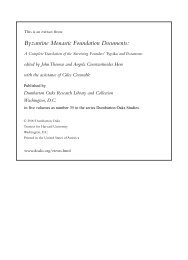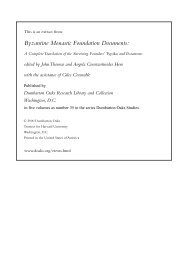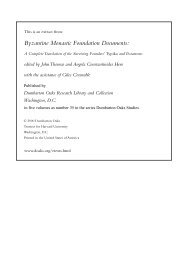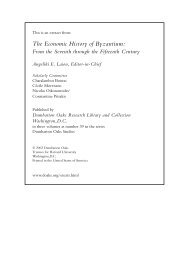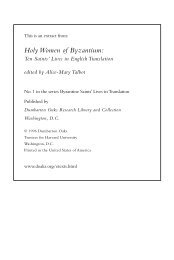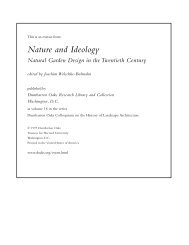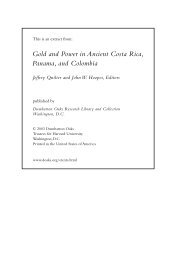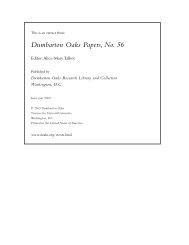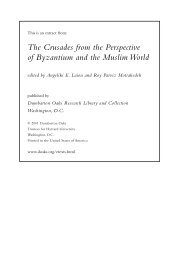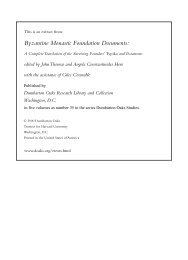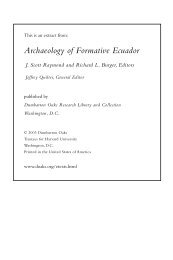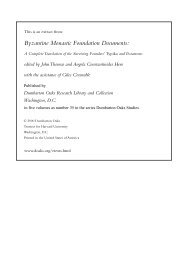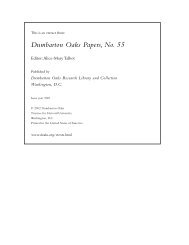22. Evergetis - Dumbarton Oaks
22. Evergetis - Dumbarton Oaks
22. Evergetis - Dumbarton Oaks
You also want an ePaper? Increase the reach of your titles
YUMPU automatically turns print PDFs into web optimized ePapers that Google loves.
ELEVENTH CENTURY<br />
superiorship). Thereafter, other authors must have introduced the present division of the work into<br />
43 chapters, re-edited certain ideologically and politically sensitive chapters like [12] and [19],<br />
and perhaps added a few final chapters of their own. The exact balance between the contributions<br />
of Timothy and his successors may not be determinable, unless some of the innovations contained<br />
in chapters [12] through the end of the document can be precisely dated from external evidence.<br />
The completion of the typikon as we have it is proposed for 1098–1118, an approximation of John<br />
Doukas’ tenure as an Evergetian monk.<br />
G. Subsequent Utilization by Later Authors<br />
(22) <strong>Evergetis</strong> was undoubtedly the most influential Byzantine founder’s typikon ever written. As<br />
noted above in <strong>Evergetis</strong>’ Institutional History, many subsequent founders utilized it either directly<br />
or indirectly, down to the middle of the fourteenth century. Later authors utilized the whole<br />
or significant parts of all of the components of (22) <strong>Evergetis</strong> except for these obviously particular<br />
sections: the introduction [1], the foundation history [2], the founder’s commemoration [35], and<br />
the appendix. Our own Appendix C: Topical Interrelationships of the Evergetian Family of Monastic<br />
Typika provides an overview of this usage.<br />
It was through the borrowing of its typikon rather than through the development of any kind<br />
of monastic order that <strong>Evergetis</strong> saw its institutions and customs introduced into many of the most<br />
influential monasteries of later Byzantium. Detailed discussions of the impact of Evergetian institutions<br />
and customs on the successor institutions for which these founders wrote their own typika<br />
will be found below under the respective textually linked foundation documents in our collection.<br />
46 To provide even a brief summary here would be tantamount to writing a concise history of<br />
Byzantine monasticism over the next two hundred years. Some general observations about the<br />
nature of subsequent utilization are in order, however.<br />
First, the seamless way later authors integrated large portions of (22) <strong>Evergetis</strong> into their own<br />
works, admitting hardly any incongruities or internal inconsistencies, speaks to their superior<br />
editorial skills. Second, many later authors were so respectful of the text of (22) <strong>Evergetis</strong> that<br />
they utilized even its most disorganized chapters, like [13] and [14], to fashion new, better organized<br />
regulations of their own, and on occasion even used parts of (22) <strong>Evergetis</strong> to shape regulations<br />
opposed to the model’s own provisions. Third, even foundation documents textually independent<br />
of (22) <strong>Evergetis</strong> nevertheless are indebted to many of its institutions and customs. This is<br />
true even in the twelfth century, but the phenomenon becomes more noticeable in the thirteenth<br />
and fourteenth centuries at the very time that direct borrowing from (22) <strong>Evergetis</strong> becomes less<br />
common. 47 Fourth, the massive indebtedness of successor institutions to <strong>Evergetis</strong> is rarely acknowledged.<br />
Only Isaac Komnenos, author of (29) Kosmosoteira [8] in 1152, comes close to<br />
admitting the essentially derivative character of much of his own work. Finally, the borrowing<br />
from (22) <strong>Evergetis</strong> soon became dependent on intermediary typika, some, like (32) Mamas that<br />
are fortunately still preserved, and others that can be only conjecturally reconstructed. This was<br />
because the dynamic of the ongoing monastic reform, particularly in the twelfth century, tended to<br />
make (22) <strong>Evergetis</strong> seem outdated in the version in which we have it. Even (22) <strong>Evergetis</strong>’ close<br />
copiers, the authors of (30) Phoberos, (29) Kosmosoteira, and to a lesser extent also (34) Machairas,<br />
seem to have used a different version, a vulgate, as it were, of the Evergetian typikon.<br />
[ 468 ]




